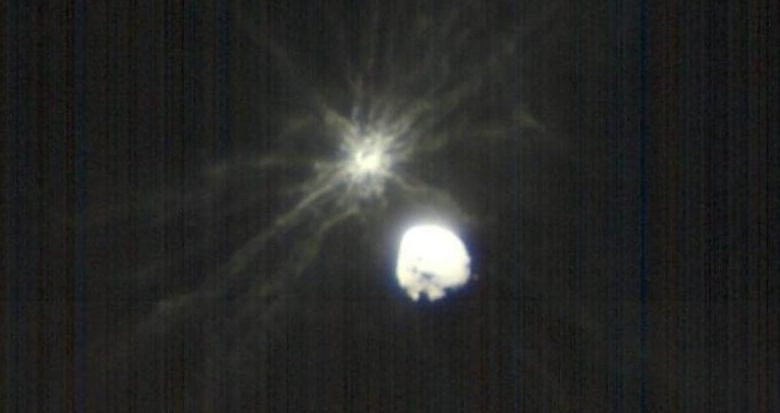What NASA’s Crash Into an Asteroid Looks Like

NASA’s DART spacecraft was not able to take pictures of the very moment it slammed into an asteroid on Monday at more than 14,000 miles per hour. Or the aftermath.
But telescopes on Earth, seven million miles away, were watching. The images they recorded revealed a spectacular outburst of debris rising from the asteroid after the collision.
The celestian show was a bonus to the spacecraft’s main objective of demonstrating a method for defending the planet from deadly space rocks in the future.
“I saw the ground-based images in the minutes after impact, and they were absolutely phenomenal,” said Cristina Thomas, a professor of astronomy and planetary science at Northern Arizona University and the lead of the observations working group for the mission.
Take, for example, the sequence depicted above that was captured with a 20-inch telescope in South Africa. It shows the asteroid Didymos, about half a mile wide, moving across the night sky. What cannot be seen is Dimorphos, the 500-foot-wide moon of Didymos — and the target of DART.
“Our telescope in South Africa — we simply pointed in the direction of the asteroid,” John Tonry, a professor of astronomy at the University of Hawaii, said. “And we started taking images every 40 seconds.”
The sudden brightening comes from a cloud of debris tossed into space by the impact of the spacecraft into Dimorphos.
“We didn’t really expect to see such a big plume of dust coming out,” Dr. Tonry said. “But, you know, discovery favors the prepared.”
Dr. Tonry is co-principal investigator of the Asteroid Terrestrial-impact Last Alert System, or ATLAS, which uses the South African telescope and three others around the world to scan the sky for asteroids that might be on a collision course with Earth.

The penultimate image transmitted by the DART spacecraft at a distance of about seven miles and two seconds before impact. Credit…NASA/Johns Hopkins APL
Even though the telescope was nearly half a world away from him, Dr. Tonry saw the pictures seconds after they were taken. “That’s the amazing thing about the internet,” he said. “We looked at the picture and said, ‘Oh my God, look at that. Wow.’”
Dr. Tonry was surprised by how much debris was knocked off the asteroid and how fast it was moving. “This stuff was screaming out at two kilometers a second, like 4,000 miles an hour,” he said. “And so within an hour, that cloud was as big as the Earth.”
Most of the debris was ejected from the point of impact, moving away from the side where DART struck. “Which is exactly what you’d expect for a plume to be recoiling off the surface,” Dr. Tonry said. But he said there also appeared to be a shell of debris rising from the opposite side, moving in the same direction as DART.
“It may be that DART created a wave that went right through Dimorphos and kind of blasted stuff off the far side,” Dr. Tonry said.
Right after the impact, the brightness jumped by a factor of 10 from sunlight bouncing off the debris. It has dimmed since then, but the dot is still four times as bright compared with what it was. A cloud of slower moving debris that remains in the vicinity of Didymos and Dimorphos is likely to fall back to the surfaces of the two asteroids in the coming weeks.
A similar sequence of images was taken by another telescope in South Africa by Amanda Sickafoose, an astronomer who lives in South Africa but works for the Planetary Science Institute based in Tucson, Ariz., and Nicolas Erasmus of the South African Astronomical Observatory. (South Africa was a prime location for viewing the impact.)
“Seeing the ejecta was phenomenal,” Dr. Sickafoose said. “I feel like I might never have the opportunity to see something like that again in my life.”




Four images taken by the LICIACube, a spacecraft that trailed DART to take before-and-after photos of Dimorphos.Credit…ASI/NASA
On Monday, the Italian Space Agency released images that were taken by LICIACube, a shoebox-size spacecraft that trailed DART to take before-and-after pictures of Dimorphos.
In images after the impact, “the ejecta cloud is very complicated,” said Angela Stickle, a planetary scientist at the Johns Hopkins University Applied Physics Laboratory and the lead for the group of scientists who performed computer simulations of the impact. “You get sort of things that look a little bit like streamers. You get sort of asymmetric ejection. And so it is definitely very complex.”
All of the plume data gives Dr. Stickle and her colleagues plenty to work with as they try to understand the structure and composition of Dimorphos. The large plume and the boulder-strewn surface that DART saw upon approaching the asteroid indicate a rubble pile that Dr. Stickle said was loosely held together.
The other key measurement is the orbital period of Dimorphos around Didymos; it was 11 hours and 55 minutes before the smashup. But the head-on impact would have sapped some of Dimorphos’s momentum, causing the moon to fall closer to Didymos. The size of the change — expected to be about 1 percent — would give an indication of how much material was kicked off the surface.
“Once we get the period change measurement from the telescope,” Dr. Stickle said, “then we can start matching that to our simulation.”
